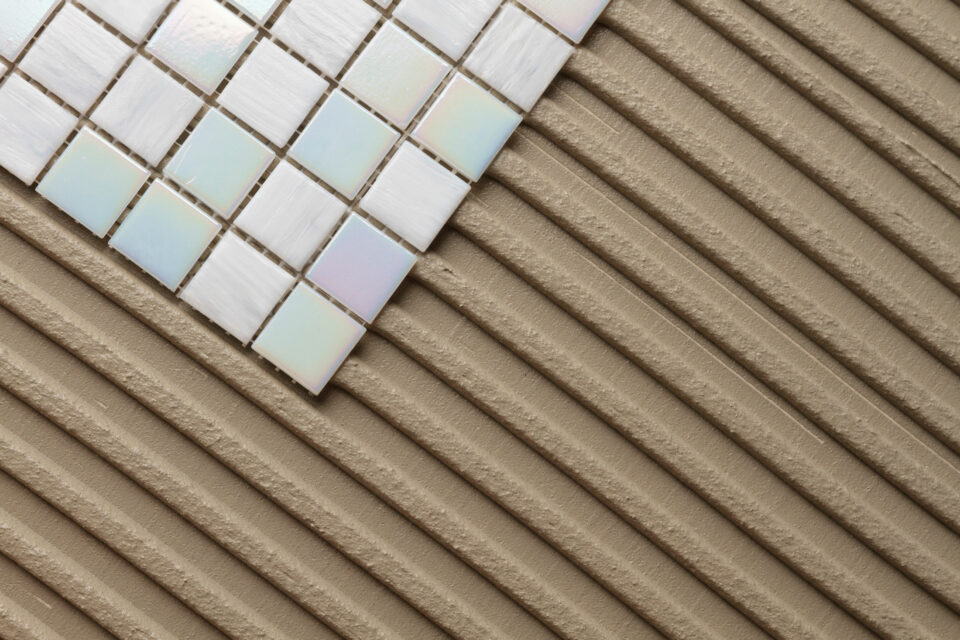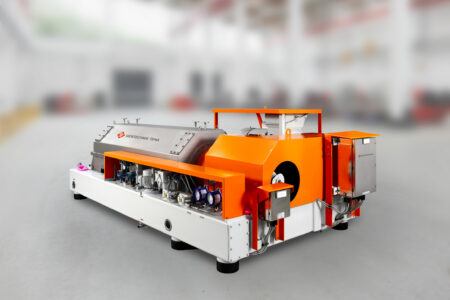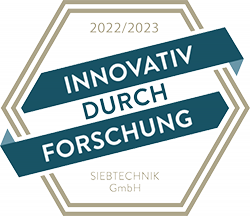Screen scroll centrifuge CONTURBEX
The CONTURBEX is a continuously operating, filtering centrifuge with a very wide range of applications.
Cellulose ethers are a group of chemical compounds made by modifying cellulose, a naturally occurring polymer found in plant cell walls. These modified cellulose molecules have specific properties that make them extremely versatile and useful.
Due to their ability to bind water and their high solubility in water, cellulose ethers are used in various industries.
For more than 60 years, these versatile products have played an important role in a wide range of applications, from building products, ceramics and paints to food, cosmetics and pharmaceuticals.
Cellulose ethers are used as thickeners, binders, stabilizers, suspension aids, surfactants, lubricants, water retention agents, coating additives and emulsifiers.
Aqueous solutions of certain cellulose ethers gel thermally, a unique property that plays a key role in a surprising variety of applications. This valuable combination of properties is not found in any other water-soluble polymer.
The fact that so many useful properties are present simultaneously, and often in combination, can be a significant economic advantage. In many applications, two, three or more ingredients would be required to accomplish the same task as a single cellulose ether product.
In addition, cellulose ethers are highly efficient, often achieving optimum performance at lower concentrations than other water-soluble polymers.
Celluloseether werden aufgrund ihrer vielfältigen Eigenschaften in zahlreichen Branchen und Industrien eingesetzt.
Cellulose ethers are used in a wide variety of industries due to their diverse properties.


The different types of cellulose ethers have different chemical structures and properties, resulting in different applications and uses. What they all have in common, however, is their ability to bind water, thicken and act as stabilizers in aqueous systems, making them versatile additives in a variety of industries.
MC (methyl cellulose): A water-soluble cellulose ether containing methyl groups. It is used as a thickening and stabilizing agent in food, pharmaceutical, construction and many other applications.
MEHEC (Methyl Hydroxyethyl Cellulose): It is a water-soluble cellulose ether with methyl and hydroxyethyl groups. It is used as a thickening and stabilizing agent in aqueous systems.
HEMC (hydroxyethyl methyl cellulose): A water-soluble cellulose ether with hydroxyethyl and methyl groups. Used as a thickening and stabilizing agent in construction, paints and coatings, and pharmaceutical products.
HPMC (hydroxypropyl methyl cellulose): A water-soluble cellulose ether containing hydroxypropyl and methyl groups. It is used as a thickening and stabilizing agent in the construction, cosmetics, pharmaceutical, and other industries.
HEC (Hydroxyethyl Cellulose): A water-soluble cellulose ether containing hydroxyethyl groups. It is used in paints, coatings, cosmetics and detergents as a thickener and rheology modifier.
EHEC (ethyl hydroxyethyl cellulose): It is a water-soluble cellulose ether containing ethyl and hydroxyethyl groups. It is used as a thickening and stabilizing agent in the construction, pharmaceutical and cosmetic industries.
CMC ( Carboxymethyl cellulose): A water-soluble cellulose ether containing carboxymethyl groups. It is used in food and pharmaceutical products and as a thickening and stabilizing agent in various applications.
(MC) Methyl cellulose ethers are most commonly used for numerous applications in the construction industry.
Methyl cellulose (MC) and methyl cellulose derivatives such as hydroxypropyl methyl cellulose (HPMC) and hydroxyethyl methyl cellulose (HEMC) belong to the group of non-ionic cellulose ethers. These products are obtained by etherification, in which water-insoluble cellulose is converted to water-soluble cellulose ethers.
MC derivatives are produced in a wide range of performance characteristics such as solution viscosity and chemical composition. HPMC and HEMC are referred to as mixed ethers because they contain different types of substituents that impart both hydrophobic and hydrophilic properties to the product.
Methyl cellulose has become a collective term for many different types of the „MC“ family.
Today, MC and its mixed ethers are used as thickeners, binders, film formers and water retention agents. They are also used as suspension aids, surfactants, lubricants, protective colloids and emulsifiers. Solutions of MC derivatives gel thermally, a unique property that plays a key role in a variety of applications.
The construction industry is by far the most important application for mixed ethers. MCs influence the water retention capacity, consistency, adhesion and plasticization of plasters, renders, adhesives, grouts and fillers, as well as specialty concretes based on mineral or dispersion-based systems.
HEC is a non-ionic, water-soluble cellulose ether. Through chemical reaction with ethylene oxide (EO), the molecular chains of cellulose are converted into a range of soluble, easy-to-handle industrial products.
The major commercially available types are completely soluble in hot or cold water and are produced in a wide range of solution viscosities. HEC is used as a water thickener, protective colloid, binder, stabilizer and suspending agent in a wide variety of industrial applications. The largest single industrial application is in latex paints.
Another derivative is ethyl hydroxyethyl cellulose (EHEC). It is a water-soluble cellulose ether produced by chemical modification. It is widely used in the construction industry as an additive to mortars and plasters, in the pharmaceutical industry for the production of tablets, and in cosmetics and paints as a thickening and stabilizing agent.
CMC or cellulose gum is a cellulose ether produced by reacting alkali cellulose with sodium monochloroacetate under strictly controlled conditions.
CMC is used as a viscosity modifier or thickener and to stabilize emulsions in a variety of products, both food (e.g. ketchup) and nonfood (e.g. paper). It is used mainly for its high viscosity, is non-toxic and is generally considered hypoallergenic as the main fiber source is either softwood pulp or cotton linters.
Non-food applications include toothpaste, laxatives, diet pills, water-based paints, detergents, sizing agents for textiles, reusable heat packs, various paper products and also in leather processing for smoothing edges.


Our centrifuges have been used for the separation of cellulose ethers and their derivatives since the 1970s. All leading manufacturers in Europe, Asia, North and South America use our centrifuges worldwide in a variety of production stages, some of which are gas-tight.
Separation and product washing by centrifugation is essential to remove impurities and by-products from the desired end product, the cellulose ether, and to ensure its purity and quality. This is because various reagents and chemicals are used in the chemical modification of the cellulose feedstock to produce cellulose ethers.
These reactions can result in complex mixtures that may contain by-products, unwanted impurities and unreacted reagents in addition to the desired cellulose ether.
Pure cellulose ethers with specific properties are required to achieve the desired functions and performance. The use of centrifuges is therefore an essential step in obtaining high quality cellulose ethers with defined properties.


SIEBTECHNIK TEMA centrifuges are specially optimized for the respective separation task. When selecting materials, austenitic and ferritic stainless steels have proven themselves in centrifuge construction for applications subject to normal stresses.
For processes in which abrasive materials are processed, the centrifuges must be provided with effective wear protection. Starting with hard coal processing, we have been continuously developing wear protection systems since 1922.
Our centrifuges can be equipped with highly developed wear protection systems made of e.g. tungsten carbide, Stellite® or ceramic tiles, to name but a few. Rubber coatings or matrix coatings have also proven themselves in various applications.
If required, our engineers develop new and efficient solutions in coating, bonding and joining technology for our customers worldwide.
Centrifuge components must not only withstand high forces, but also process-related stresses such as corrosion, wear and high temperatures. Cost and availability of materials also play an important role. Our customers select the necessary product-contacting materials according to these very specific requirements.
Duplex and high-alloy stainless steels, Hastelloy® and titanium materials for a wide variety of processes and stresses are part of our daily business in centrifuge construction. Our quality management has developed very detailed and cost effective processes for design, manufacturing processes and component testing based on European guidelines.
Typical sheet metal and forging materials for centrifuge wetted components include

The CONTURBEX is a continuously operating, filtering centrifuge with a very wide range of applications.

Our decanters are individual, functional and versatile. They offer highly efficient separation of even the finest solids with almost complete clarification of the liquid phase.

SIEBTECHNIK TEMA Remote Advanced Monitoring
Your digital module for preventive centrifuge maintenance - with optional cloud connection

We have developed an oil quality monitoring system specially tailored to our centrifuges. Reduce downtimes and extend your machine running time with the SIEBTECHNIK TEMA Fluid Observer!

Our centrifuge & dryer systems offer you state-of-the-art technology, customer and product-specific special equipment, individual advice in pre-sales and reliable support in the after-sales process.

Sustainable & effective dewatering using centrifuges. Our solutions are sustainable and tailor-made - for a wide range of applications in a wide range of industries.

Find the right contact for your region.
We have the right solution for every task. And if not, we’ll work with you to find one. Get in touch with us!
Our specialists will be happy to advise you individually on site or remotely, and are available to answer any questions you may have. Send us a message using our
